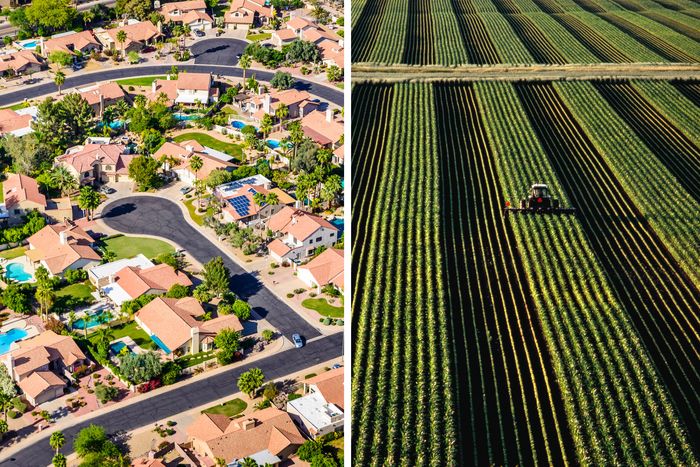
If the Democrats’ solid midterm win had been a little bit bigger and a little bit wider, the Donkey Party might have turned towards the 2020 cycle feeling so confident about its prospects that any questions about geographical strategy would involve choices among very good options. Instead, if you look at the 2018 results in terms of the states they will need to deny Donald Trump a second term in office, it’s all a bit ambiguous. Twenty-four of the 39 House seats Democrats flipped (so far) were in states carried by Hillary Clinton in 2016. Four of the seven governorships they conquered (pending final results in Florida and Georgia) were in HRC states as well, as was one of the two Senate seats they turned around (pending the final results in Florida). In other words, the 2018 gains weren’t all or even mostly in enemy territory when it comes to the states that will cast 2020 electoral votes. That leaves some tough strategic decisions.
The Heartland
The two most obvious regional strategies for Democrats are to win back the heartland/rust belt (depending on how you think about them) states that Trump narrowly carried despite a strong history of going the other way: Michigan, Pennsylvania and Wisconsin. There are two similar additional states that Obama carried twice: Iowa and Ohio.
At the other end of the spectrum are sunbelt states that were already quite close (Florida and North Carolina) or that have recently been trending Democratic (Arizona, Georgia and Texas) at varying rates. It is very difficult to extrapolate midterm results into a reliable projection of presidential results. Let’s say for the sake of argument that the political environment begins to lean more Republican between now and 2020 (typically presidential parties do make some gains after the initial midterms are over). Does that mean sunbelt states that Trump carried in 2016 will be further out of reach than ever for Democrats, or that the heartland states where he so shockingly surged will win it for him again? It’s hard to say.
According to the New York Times, Democrats won the House popular vote in Michigan by a 54/46 margin this year. But at the same time, Senator Debbie Stabenow underperformed (relative to the 2016 vote) all but one of the Democratic incumbents running in states Trump carried. Democrats were excited to finally topple Wisconsin Governor Scott Walker, and Senator Tammy Baldwin easily defended her Senate seat. But down-ballot Democrats made no dent in the state’s five-three Republican advantage in House seats, and Republicans actually strengthened their hold on the state legislature. In Ohio, Republicans won the House popular vote by four points, and also won every statewide election other than Sherrod Brown’s Senate reelection. And in Iowa, while Democrats won two U.S. House seats, Republicans held onto the governorship and the state legislature. Residual Republican strength among the non-college-educated white voters that are so important in the heartland could limit Democratic opportunities.
The Sunbelt
The Sunbelt route to a 2020 win, however, is just as complicated. Democrats won Senate seats in Arizona and Nevada, came very close in Texas and Florida, and had historic (if losing) gubernatorial candidacies in Florida and Georgia. They flipped House seats in Arizona, Florida, Georgia and Texas (along with such deep-red states as Oklahoma and South Carolina). Sharply higher minority turnout and overall demographic trends are beginning to make Arizona look blue and Georgia and Texas look at least purplish. That great sleeping giant, the Latino vote, is awakening and making Texas look much more promising for Democrats like Beto O’Rourke, as Thomas Edsall observes:
The Pew Research Center found that Hispanics in Texas voted for O’Rourke over Cruz 64-35. Historically, Hispanic turnout rates have been low. But in 2018, the Dallas Morning News reported, Hispanic turnout increased over 2014 by large percentages in heavily Latino counties: Dallas County (an 86 percent increase); Hidalgo (a 105 percent increase), Cameron County (a 115 percent increase); El Paso County, O’Rourke’s home base (a 168 percent increase).
The real wild card is that the minority voters so crucial to Democratic prospects in the sunbelt typically turn out to vote at significantly higher levels in presidential years. If the turnout boom of 2018 is just a sign of things to come for such voters, that could push many of these states into even more competitive territory.
Conor Sen argues that the 2020 Senate map should count for something in the Democratic debate over regional targeting that year:
As Democrats mull over these differing approaches, the tiebreaker might be the 2020 Senate map. The Senate races in the Midwest — Kansas, Nebraska, Iowa — seem less likely to be competitive than those in the Sun Belt. Democrats are increasingly competitive in Arizona, Texas, Georgia and North Carolina, for instance.
In the end, the Democratic presidential strategy for ejecting Trump in 2020 will follow the polls — hopefully better and more frequent polls than those taken by the Clinton campaign in those heartland states that ultimately cost them the election of 2016 — and perceived opportunities. And the identity of the presidential nominee will matter a great deal. If Democrats nominate someone like Ohio’s Sherrod Brown, a heartland strategy would be natural. Obviously, if Beto O’Rourke decides to take his particular brand of charisma and fundraising prowess into the presidential race, a sunbelt strategy makes sense. And potential candidates ranging from Joe Biden to Elizabeth Warren to Kamala Harris have their own strengths and weaknesses that will help shape the map. In any event, after years and years in which both parties endlessly jousted over Ohio and Florida and often ignored much of the country, an election open to more possibilities might be refreshing.






























